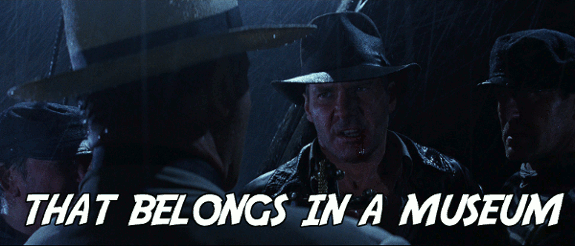First Drafts & Scraps of Paper
How collectors, copyright, and the ephemeral nature of our hobby are contributing to the loss of our sub-cultural heritage.
Andrew Eakett
aeakett@gmail.com
The RPG hobby is a young one. While wargames and bespoke examples existed earlier, it’s probably safe to say that it was popularly born with the initial release of D&D 40 years ago. Perhaps because of this, popular scholarship is just beginning. Works by Peterson and Ewalt, as well as two upcoming documentaries on the history of Dungeons & Dragons are hopefully only the beginning of of an attempt to increase our understanding of the games that have been so important to so many. Unfortunately the primary progenitors of our hobby are recently deceased, and many of the people that were present at the dawn of RPGs are advancing in age. And while a great deal of popular published material is generally available, that availability is generally proportional to its initial popularity. Some very early and ephemeral material is quite hard to obtain. Libraries hold a few issues of the Domesday Book for example, and while others are extant, they are privately held and essentially inaccessible. To my knowledge, none are widely accessible. All of these factors lead to a situation where some of the more obscure historical elements of RPG history are disappearing or inaccessible to casual researchers.
Perceived Value
Early on, this was just the hobby of some crazy guys in the mid-west. It’s unlikely that anybody thought that their work would be important. Conversely, it’s likely that all kinds of notes and material that the emergent scholarly community would love to see was disposed of. This attitude is still prevalent today. One particularly startling example is the near loss of a storage locker filled with some of Dave Arneson’s notes, models, and various printed material. Thankfully, one man has taken it upon himself to start PlaGMaDA, an organization that seeks to “preserve, present, and interpret play generated cultural artifacts, namely manuscripts and drawings created to communicate a shared imaginative space.” In my opinion, this is a wonderful start. After all, could a young James Jacobs have known that his homebrew campaign would later serve as a basis for a major campaign setting?
Collectors
Collectors are both one of the great heroes, and greatest threats in the current situation. They are incessant researchers who can be well connected, and tend to be founts of obscure information. They have also had the foresight over the years to preserve things that would probably not still exist otherwise. On the other hand, they are private individuals who have no responsibility (or inclination in many cases) to widely share what they have. And why should they? They’ve often spent considerable time and effort putting their collections together. In the end though, this leads to a centralization of information which can make casual access for amateur researchers problematic. Another concern is how well these private collections are cared for. While I don’t mean to question the motivations or qualifications of collectors, the fact is that their collections are almost certainly stored in an extra room in their house. No climate control, no professional monitoring, and no disaster plan. All to be expected, but still worrisome.[1] I would suggest that collectors who have completely, or relatively unique items make copies of them. I realize that this sort of practice is probably frowned upon by collectors since in a way it reduces the value.[2]
Copyright
The single greatest threat to our sub-cultural heritage is copyright. There is often a great reverence for the creators of the games we play, and it’s fairly well known that nobody has ever gotten rich designing or publishing RPGs. Because of those facts, people with access to rare items are often overly (in my opinion) hesitant to share them. While I’m sympathetic to individual creators (and small companies), I believe that they have a moral responsibility to keep their work reasonably available, and to provide provisions for the release of material in the event of their deaths. Larger corporate IP owners I have less sympathy for. Either they should keep works reasonably available or they shouldn’t complain about copies being made and distributed.
The Role of Traditional Institutions

Donating rare and unique items to a museum or library could be a sollution. Indeed there are plenty of rare items in several different collections, though they tend to be part of larger, more general collections (usually general popular culture collections). This could prove problematic in the long run as institutional collections policies may dictate deaccessioning materials.[3] The Strong National Museum of Play’s focus on games and play make it the most likely home for important documents.[4] But while it’s certainly a good bet for preservation, casual scholarship is still hampered by centralization.
So Now What?
Here’s how I see the current situation:
- Folk knowledge is literally dying.
- Unique items are being locked away in private collections.
- Rare items are practically inaccessible to casual researchers.
- Content creators could be doing more to provide access to their material.
Yes, I am essentially advocating piracy. I’m not suggesting the wholesale copying and distribution of readily available material (people have to eat). Think of it as an act of civil disobedience. The future cultural value of that seemingly insignificant thing that you have can’t be known, and it’s your job to make sure that somebody can find that significance in the future.
-
Take the Ernie Gygax fire for example. While certainly a terrible event from a human perspective, historically speaking the loss is nothing less than tragic. ↩
-
See this thread on the Acaeum for an example of how some collectors feel about this practice. ↩
-
New York State Library was recently in the news when it unceremoniously deaccessioned a large collection of 19th-century newspapers. ↩
-
Indeed, this is where PlaGMaDA deposits their physical artifacts and Peterson has semi-permanently loaned the Dalluhn manuscript to them. ↩